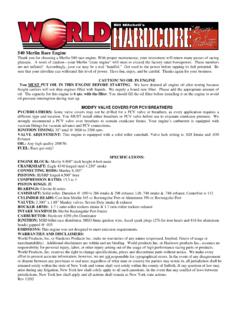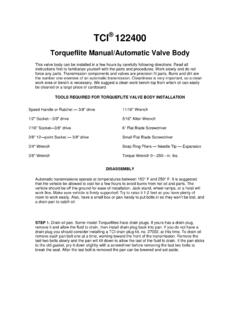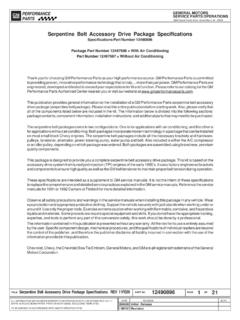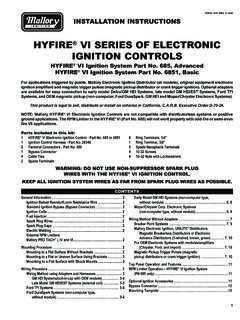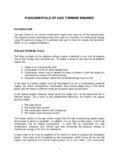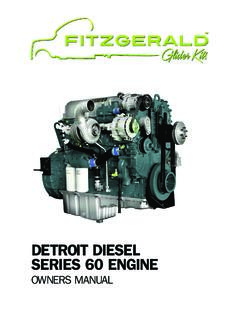Transcription of Engine Break-in Procedure - Summit Racing Equipment
1 Engine Break-in Procedure Ensure all accessories (headers, alt, power steering pump, etc) are tight and check for any water /oil leaks. Even if your Engine came complete, it s best to check all major components such as Distributor, Spark Plugs, Wires, Carburetor etc as it could have been damaged or disturbed during shipping. 1. You will need to fill the Engine with oil as they are shipped dry (Unless otherwise noted). When installing an oil filter, fill it about 1/2 way with oil and lube the rubber gasket the surrounds the filter with oil, than tighten by hand.
2 We recommend WIX or other premium brand oil filters. A cheap filter will not be cheap if it costs an Engine . We recommend Joe Gibbs Racing Oil BR orBR30 especially in flat tappet engines, if this is not available to you than a 5w30 or 10w30 with an Engine break in additive (ZDDP, or ZINC camshaft additive) will do. It is best to prime the oil system with an Engine priming tool or a Pre Luber offered by ATK even if the Engine has been dyno tested. 2. If you plan on running synthetic oils, we recommend that a new Engine is first broken in with regular mineral type Engine oil and 4000+ miles are put on the Engine .
3 If you fail to follow this Procedure , the rings may never seat. 3. The distributor timing should be set if your Engine was dyno tested and came with a dyno report, but occasionally it is disturbed during shipment. If your Engine was complete, but not dyno tested you will still need to verify timing. Non Dyno tested engines come set at about 34-36 degrees without Vacuum Advance hooked up. DO NOT ASSUME because it fired up, it is correct. If the Engine does not fire immediately you may need to recheck the timing. 4. Set the ignition timing after Engine starts.
4 Starting point for most carbureted engines is 34 degrees before top dead center with vacuum advance disconnected at 3000 rpm. Some experimentation with timing is required for optimum results with locally available fuel, but it should be between 32-38 BTDC. 5. Flat tappet hydraulic cams only - Run the Engine between 2,000 and 2,500 RPM's, with no-load on the Engine for the first 30 minutes. This is critical to break in the camshaft. We have usually performed this step at ATK if the Dyno Test and Tune option was purchased. 6.
5 Roller Cam engines do not need to follow the Procedure in step 5. 7. Remember that the cooling system on a fresh Engine swap will have a lot of trapped air, which will lead to wild temperature gauge readings and possible water pump cavitations (water pump not moving coolant due to trapped air) To help avoid trapped air in the cooling system, try to fill the cooling system up with a 50/50 mix of quality coolant and water a few hours before you plan on starting the Engine . Leave the radiator cap off during this time. This will tend to help purge a fair amount of trapped air before you start the Engine .
6 Also helpful during Break-in is to use a Lever-Vent type radiator cap on your radiator in so that you can manually purge trapped air while Engine is running- (use extreme caution to avoid being burned by hot coolant). Your normal cap can then be re-installed after Engine cools off. 8. Drive the vehicle with varying speeds and loads on the Engine for the first 200 miles. Occasional full throttle runs from a rolling start (2000 rpm or so) to 4500 will help seat things. This does not mean every other start and the Engine should be cooled after doing this.
7 At around 150 -200 miles, it is wise to check the rockers / valve clearance to insure adjusters are tight and lash is proper (do this again at 500 miles). The following two steps are not necessary, but may help speed up the Break-in process. 9. After the initial 200 miles run five or six medium-throttle accelerations to about 4500 RPM (observing local laws of course), then letting off in gear and coasting back down to 20 MPH. 10. Run a couple hard throttle accelerations up to about 5000 RPM, then letting off in gear and coasting back down to 20 MPH.
8 11. Let Engine cool and change the oil and filter and check coolant level, top off if necessary. 12. Drive the next 500 miles normally, without high RPM's (below 5000 RPM), hard use, or extended periods of high loading. It is best to avoid long periods of idling during this period. 14. Change the oil and oil filter again. At this point, you should be able to run a quality synthetic oil if you choose. If you have any questions please call our ATK Tech Line @ 800-421-3746.
